“You cannot believe the truly amazing work these doctors, nurses, therapists and social workers do, and the miracles they help kids perform on a daily basis. They are the unsung heroes of Chase's journey.”
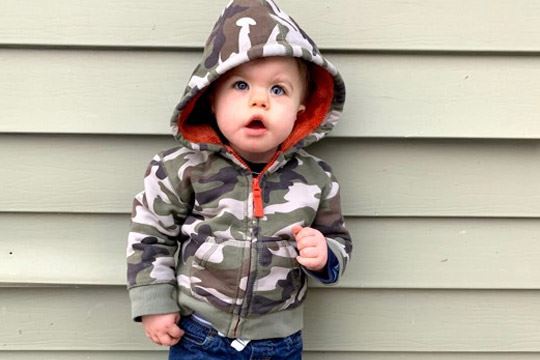
Danielle and Phil Moskowitz were enjoying the last few weeks of their first pregnancy, when Danielle’s doctor started to grow concerned; she and her baby had stopped growing and progressing as they should have nearing her due date. On June 7, 2019, at 37 weeks, Danielle had a scheduled, emergency C-section and gave birth to Chase Maverick Moskowitz, weighing 5 pounds, 11 ounces.
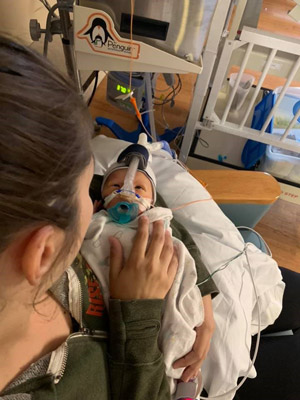 Chase was immediately taken to the Neonatal Intensive Care Unit (NICU) for difficulty breathing, where it was discovered he had sleep apnea and was placed on a mechanical CPAP machine to help him learn to breathe. An initial eye exam also indicated a coloboma, or missing piece of tissue, on Chase’s left iris, so after spending about a week in the NICU, he saw an Optometrist who found the presence of colobomas, in the back of each of Chase’s eyes. He was also diagnosed with moderate to severe conductive hearing loss after he failed his infant hearing screenings. At two weeks old, Chase was diagnosed with a tracheoesophageal fistula (TEF), which is an abnormal connection between the esophagus and the trachea, which explained why he was having a hard time breathing and eating. On June 27th, 2019, a day shy of being three weeks old, Chase had surgery to help correct the TEF and insert a G-tube for feeding.
Chase was immediately taken to the Neonatal Intensive Care Unit (NICU) for difficulty breathing, where it was discovered he had sleep apnea and was placed on a mechanical CPAP machine to help him learn to breathe. An initial eye exam also indicated a coloboma, or missing piece of tissue, on Chase’s left iris, so after spending about a week in the NICU, he saw an Optometrist who found the presence of colobomas, in the back of each of Chase’s eyes. He was also diagnosed with moderate to severe conductive hearing loss after he failed his infant hearing screenings. At two weeks old, Chase was diagnosed with a tracheoesophageal fistula (TEF), which is an abnormal connection between the esophagus and the trachea, which explained why he was having a hard time breathing and eating. On June 27th, 2019, a day shy of being three weeks old, Chase had surgery to help correct the TEF and insert a G-tube for feeding.
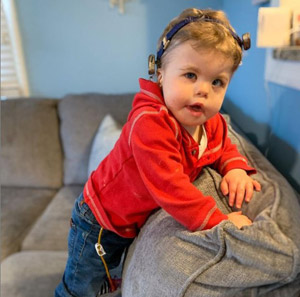 After spending eight weeks in the NICU, Chase was transferred to another hospital out of state where he could see a specialized pediatric Otolaryngologist (or ENT, ear nose and throat physician) and began occupational and physical therapy. That’s when Danielle and her husband received the confirmed diagnosis that Chase was born with CHARGE Syndrome, a rare genetic syndrome effecting 1 in 10,000.
After spending eight weeks in the NICU, Chase was transferred to another hospital out of state where he could see a specialized pediatric Otolaryngologist (or ENT, ear nose and throat physician) and began occupational and physical therapy. That’s when Danielle and her husband received the confirmed diagnosis that Chase was born with CHARGE Syndrome, a rare genetic syndrome effecting 1 in 10,000.
CHARGE is an acronym that was created to represent a complex group of features, including Coloboma of the eye, Heart defects, Atresia of the choanae, Retardation of growth and development, and Ear abnormalities and deafness. “This basically meant that when DNA replicates in early pregnancy, one protein changed which caused a domino effect and resulted in these physical abnormalities,” explains Phil. Characteristics differ from child to child, but the most common features include vision and hearing loss and balance issues that delay development and communication.
“While we suspected this early on, it took about 8 weeks for the genetic results to come back and confirm the diagnosis,” shares Danielle. “CHARGE is a really unique and rare genetic mutation that we were told is basically random! This would not have shown up on any prenatal screenings.” Of the major symptoms and characteristics of CHARGE Syndrome, Chase has colobomas and ear abnormalities. The TEF that was repaired and his trouble swallowing due to cranial nerve abnormalities, are all secondary symptoms of CHARGE.
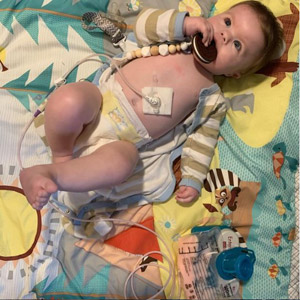 The Journey Continues
The Journey Continues
At three months old, Chase was transferred back to the hospital where he was born in New Jersey, where he stayed for two weeks as his care team started to discuss his transition home. Chase was still weak and in need of around-the-clock nursing care. That’s when doctors recommended that Danielle and Phil take Chase to Children’s Specialized Hospital. “At first, this was a bit disheartening,” shares Danielle. “All we wanted to do was bring Chase home, especially after making moves between two hospitals already. It had been such a long process I was disappointed.”
On September 20th, 2019, Chase was admitted to Children’s Specialized Hospital’s inpatient facility in New Brunswick where he began receiving speech therapy, occupational therapy and physical therapy with the goal to transition home. “One of the major reasons we decided to transition to CSH was so Danielle and I could get trained on all of Chase’s equipment before heading home,” shares Phil. “This helped us know how to work his equipment, maintain it, keep everything clean, and to look for any potential warning signs that it's becoming ineffective. We also really loved that there were services to help adapt Chase’s toys and carriers for his specific needs.”
While Phil returned to work, Danielle stayed with Chase the entire six weeks that he was at CSH, accompanying him to his therapies and receiving training on his G-tube, feedings, bath time and infant CPR to make the transition home as smooth as possible.
“His physical therapist would work on stretching, rolling, and tummy time, while his occupational therapist worked on body awareness and having Chase recognize and feel different body parts, as well as tracking things visually,” shares Danielle. “For speech therapy we worked on facial massaging to help promote swallowing, smiling and sucking to help strengthen those muscles, although he never did take a bottle. We completely skipped that stage and went right into purees and soft solids. He’s now eating about 5-6 ounces by mouth a day, thanks to help from his feeding therapists at CSH.”
“We even signed Chase up for pet therapy hoping that would get him ready for his crazy fur-sisters who were waiting for him at home,” shares Phil. “We tried to take advantage of all that was offered to our family, and the results really showed.”
After about two weeks of being at Children’s, Danielle began doing all she could on her own to mimic what it would be like bringing Chase home. “I was able to transition to giving him all his medications, preparing feeds, changings, baths, and doing care for his G-tube,” shares Danielle. “Even waking up multiple times during the night to try and calm him if he woke up crying. We also were eventually tested on all of these procedures prior to discharge. This is what I had been working on with his care team and training to do since we arrived.”
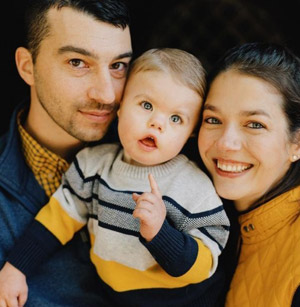 Homeward Bound
Homeward Bound
On Tuesday, November 5th, 2019, after 151 total days in three different hospitals in two states with countless numbers of doctors, nurses, and therapists, Chase finally made it home.
“Coming to Children’s’ Specialized Hospital was such a blessing for us,” shares Danielle. “I was disappointed at first that there was another step added in this process, but the training and education that they provided us really helped me significantly in gaining the confidence to bring Chase home without being terrified! I knew what to do to care for him and bringing him home was smooth sailing.”
Today, a year and a half later, Chase is enjoying his time at home with his two fur-sisters and is doing phenomenal. Danielle shares that he continues with feeding therapy, early intervention, vision and speech therapy, and he can sign 80-90 words using American Sign Language (ASL).
“CHARGE is actually the number one cause of deaf-blindness,” says Danielle. “Chase was fitted for cochlear BAHA’s (Bone Anchored Hearing Aids) at six months old, which has helped his hearing significantly, and miraculously Chase can see! It’s really amazed all the eye doctors we’ve seen!”
When asked their advice for other families who may be embarking on a similar journey, Danielle shares her biggest takeaway is not to be afraid. “I was disappointed that we were getting transferred again and I wasn’t taking Chase home, but CSH did not disappoint. Everyone we met was overwhelmingly nice and helpful. They really helped to make me feel as comfortable as possible while living in the hospital for 6 weeks with my first child.”
Danielle and Phil continue on to share that Chase has an amazing sense of humor, loves anything musical, and riding his Paw Patrol car outside. He also loves his tumbling mats and new found independence with his gait trainer that he recently received.
“I have so many hopes for Chase in the future,” shares Danielle. “I want him to be the best possible person he can be; I just want him to be happy in whatever he decides to do. Of course, a world of inclusivity is the biggest dream we can have.”
“It really has been one unbelievable journey that we could have never envisioned or imagined to get to where we are today,” shares Phil. “You cannot believe the truly amazing work these doctors, nurses, therapists and social workers do, and the miracles they help kids perform on a daily basis. They are the unsung heroes of Chase's journey.”